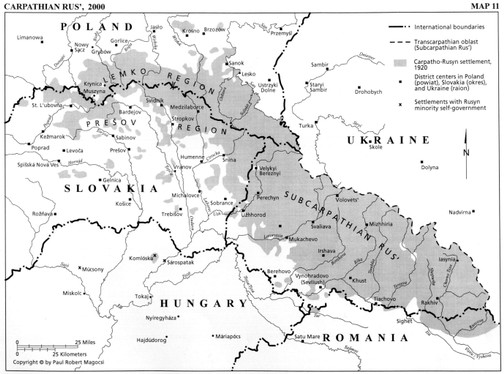Rusyns - Slavjane
Main menu:
The Carpatho-Rusyns are a small East Slavic nation indigenous to the Carpathian Mountain region of East Central Europe. Their homeland roughly spans the western part of the Carpathian Mountain range, and currently falls within the borders of several European countries. Most of the Carpatho-Rusyn territory was, for much of its  history, entirely within the borders of Austria-Hungary. When that empire was dissolved at the close of World War One, the majority of Carpatho-Rusyn territories became an autonomous part of Czechoslovakia, called Subcarpathian Rus. This made Rusyns one of the three founding peoples of Czechoslovakia (along with the Czechs and Slovaks). The Rusyns of Austrian Galicia were incorporated into the new Polish state, and other Rusyns found themselves as minorities in northern Romania, the new Yugoslavia, and the smaller Hungary.
history, entirely within the borders of Austria-Hungary. When that empire was dissolved at the close of World War One, the majority of Carpatho-Rusyn territories became an autonomous part of Czechoslovakia, called Subcarpathian Rus. This made Rusyns one of the three founding peoples of Czechoslovakia (along with the Czechs and Slovaks). The Rusyns of Austrian Galicia were incorporated into the new Polish state, and other Rusyns found themselves as minorities in northern Romania, the new Yugoslavia, and the smaller Hungary.
 history, entirely within the borders of Austria-Hungary. When that empire was dissolved at the close of World War One, the majority of Carpatho-Rusyn territories became an autonomous part of Czechoslovakia, called Subcarpathian Rus. This made Rusyns one of the three founding peoples of Czechoslovakia (along with the Czechs and Slovaks). The Rusyns of Austrian Galicia were incorporated into the new Polish state, and other Rusyns found themselves as minorities in northern Romania, the new Yugoslavia, and the smaller Hungary.
history, entirely within the borders of Austria-Hungary. When that empire was dissolved at the close of World War One, the majority of Carpatho-Rusyn territories became an autonomous part of Czechoslovakia, called Subcarpathian Rus. This made Rusyns one of the three founding peoples of Czechoslovakia (along with the Czechs and Slovaks). The Rusyns of Austrian Galicia were incorporated into the new Polish state, and other Rusyns found themselves as minorities in northern Romania, the new Yugoslavia, and the smaller Hungary. By the close of World War Two, the Rusyn territories had been again divided. Subcarpathian Rus was invaded by Soviet troops and incorporated as a province of the Ukrainian SSR. The Lemko Rusyns of Poland were forcibly relocated by the communist Polish government to western Poland and Ukraine and their properties confiscated by Poles. In Czechoslovakia, Poland and Soviet Ukraine, the official government policy became one of ethnocide, in which Carpatho-Rusyns were not permitted to exist as a separate nation but were recognized only as Ukrainians. Only in the Socialist Federative Republic of Yugoslavia was the Rusyn nation legally allowed to develop and flourish, with Rusyn becoming one of the five official languages of the Serbian republic's autonomous Vojvodina province in 1974.
With the fall of communism in the late 1980s and early 1990s, Rusyns experienced a renaissance of their language and culture. Today, the Rusyns are recognized by the Bosnian, Croatian, Czech, Hungarian, Polish, Romanian, Russian, Serbian, Montenegrin, and Slovak governments as a distinct people. In most of these countries, the Rusyn language has been codified and is taught in elementary schools, high schools and even at the university level. It is regularly used in books and periodicals, on the radio and television, in the theatre and even in government administration.

On December 1, 1991, the Carpatho-Rusyns of Transcarpathia in Ukraine voted overwhelmingly for autonomy within the new Ukrainian state. This has not been achieved. The Ukrainian government is the only country in all of Europe with a Rusyn minority which does not recognize them as a distinct people.
Today, Carpatho-Rusyn territory falls within the borders of Hungary, Poland, Romania, Slovakia and Ukraine, with large Rusyn immigrant populations in Australia; Canada; the Srijem region of Croatia; the autonomous Vojvodina province of Serbia; and the United States. Smaller Rusyn communities live in Bosnia, the Czech Republic and Russia.
About 700,000 Americans are of Rusyn descent, with the largest concentration of these people (about 60,000) in western Pennsylvania. Other large Rusyn-American settlements include the metropolitan New York City region; Binghamton, New York; Connecticut; the metropolitan Cleveland region; the metropolitan Chicago region; Wilkes-Barre/Scranton, Pennsylvania; Hazleton/Pottsville, Pennsylvania; Minneapolis; and Detroit.
Home Page | History | Member Benefits | Gallery | Location | Rusyns | Rusyn Dance | Contact Us | Members Only | General Site Map